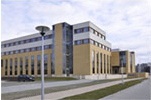2. Singularity formation, critical behavior, and topology change for geometric heat flows
|
Polish supervisor:
|
Piotr Bizoń
|
|
Cooperating partners:
|
Israel M. Sigal (University of Toronto)
Juan J.L. Velazquez (Universidad Complutense Madrid)
|
The heat flow equation ut=Lu has proven to be a very useful
tool in understanding solutions of the elliptic equation Lu=0.
In particular, if this elliptic equation follows from a
variational principle, then stationary solutions of the flow are
the critical points of the corresponding variational functional so
one might hope to find them as the asymptotic states of the flow
for t → ∞. The major difficulty in implementing
this idea (which was pioneered by Eels and Sampson in the sixties)
is the fact that the flow may develop singularities in a finite
time. If this happens, one must find a way to continue the flow
past a singularity, possibly in a unique manner. Let us note aside
that a similar problem of continuation beyond singularities arises
for other geometric flows and overcoming it was essential in two
recent major breakthroughs in geometric analysis, namely the proof
of Thurston's geometrization conjecture by Perelman (using the
Ricci flow) and the proof of Penrose's inequality by Huisken and
Ilmanen (using the inverse mean curvature flow).
The goal of this project is to study the heat flow equation for
harmonic maps (for different domains and targets) and Yang-Mills
equations in supercritical dimensions. Although this is an old
subject (especially in the case of harmonic maps), very little is
known about the precise asymptotics of singularity formation, not
to mention the continuation beyond a singularity. Under this
project the student is expected to work on: i) construction of
self-similar shrinking and expanding solutions by ODE techniques,
ii) analysis of (non)-uniqueness of gluing shrinking and expanding
self-similar solutions through a singular point and the
corresponding change of degree, iii) spectral problems related to
the stability of self-similar solutions, iv) implementation of a
finite-difference moving mesh code which would be able to resolve
the structure of singularity formation, v) analysis of so called
Type II blowup mediated by an adiabatic shrinking of stationary
solutions, vi) construction of saddle-type stationary solutions by
a min-max heat-flow argument.
|




|
|



